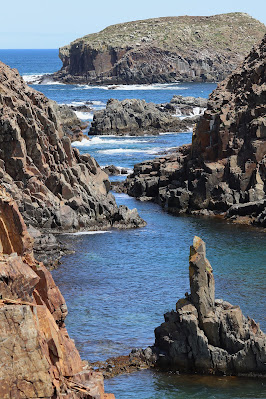Puffin Day!
It was a long drive to Elliston on the NW corner of the Avalon Peninsula, but it was definitely worth it! The site offers the closest view of Atlantic Puffins from land in North America. Hundreds of nesting pairs roost on a rocky outcrop. It only takes about 5 minutes from the parking area to walk to the best viewing point. As we headed toward the nesting grounds, a pair of Puffin Chairs welcomed us to the site!
Scenic views along the walk to the Puffins.
A sharply dressed black-and-white seabird with a huge, multi-coloured bill, the Atlantic Puffin is often called the "Clown of the Sea."
https://www.allaboutbirds.org/guide/Atlantic_Puffin/overview
They breed in burrows (visible in photo) in the North Atlantic, and winter at sea. Puffin chicks are called Pufflings. We didn't see signs of any hatched Pufflings.
https://www.allaboutbirds.org/guide/Atlantic_Puffin/overview
The Atlantic Puffin is the official bird of Labrador and Newfoundland!
Time to stretch the wings!
Checking out the scenery!
The best time of year to find Atlantic Puffins is in the spring breeding season when they come to shore to nest.
Atlantic Puffins dig a shallow hole or burrow into the ground with their bill and feet. Both sexes share the task, with the male typically doing more excavation than the female. On rocky islands, they make a nest under a boulder or within a crevice among the rocks. Pieces of grass and twigs often line the bottom of the burrow. Pairs tend to reuse the burrow year after year. Puffins lay one egg which is incubated for approximately 40 days.
https://www.allaboutbirds.org/guide/Atlantic_Puffin/lifehistory#nesting
In flight, Atlantic Puffins flap their small wings frantically to stay aloft, but underwater, the wings become powerful flippers that allow the birds to catch small fish.
https://www.allaboutbirds.org/guide/Atlantic_Puffin/overview
Despite the windy, rugged conditions, butterflies floated around the edges of the cliffs and occasionally stopped for a nectar break. A Short-tailed Swallowtail kindly posed for a photo! (Black Swallowtails do not live in Newfoundland.)












.JPG)



Looks magical, great pictures!
ReplyDelete